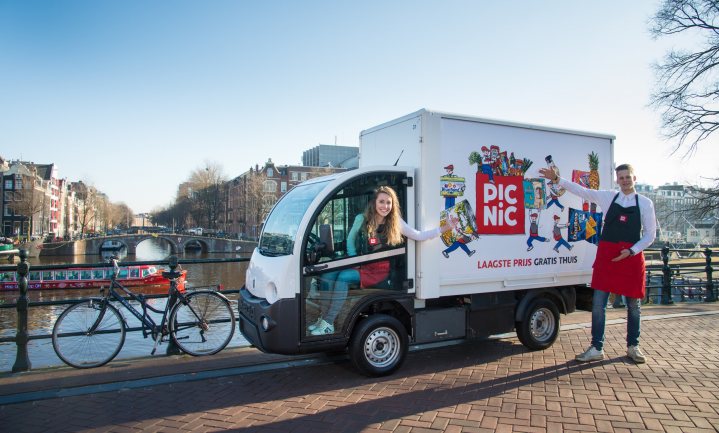
Picnic is a Dutch online retailer which started its operations in 2015. Picnic is unique in the Dutch retail market since it doesn’t own any physical stores. Picnic operates on your smartphone via its app, it is known for delivering its products to consumers via a small electronic trolley. Thanks to its data-driven business model Picnic is able to deliver its products fast, at a low price and moreover; free of delivery costs (Staalduine, 2016)
In 2017 Picnic tripled their revenue to €100 million, and for 2018 they expect to earn €300 million and so tripling their revenue for the second time in a row (Distrifood, 2018). This enormous expansion doesn’t go by unnoticed by their competitors. The Dutch retail market is dominated by Picnic’s two main competitors: Albert Heijn and Jumbo, together they account for 52% of the market (Vermijs, 2017). Both competitors launched a groceries home delivery service of their own, utilizing all their scale advantages to battle Picnic’s rise. For now, they seem to succeed, Jumbo has an online revenue of €140 million and Albert Heijn €400 million (this includes the online revenue of their sister companies Etos and Gall & Gall).
Looking at Europe’s leader and pioneer in home-delivered groceries the United Kingdom, the future looks bright for Picnic. In the UK 5% of the total groceries purchases are home delivered, in the Netherlands this is still only 1,6% so there is still a lot of room to grow (Staalduine, 2016). And growing is exactly what Picnic will keep on doing, at the moment it’s growing even faster than its supply chain can keep up with, in Utrecht for example they have a waiting list of over 1.500 people. Moreover, Picnic is all about thinking big, they recently announced their first international expansion towards Germany, starting operations in the Ruhr valley coming year. Picnic has proven to offer a unique value for its customers, and therefore I believe we will be seeing a lot more of it in the coming years
References:
Garstenveld P. (2017, 21 september). AH Online naar €400 miljoen omzet. Geraadpleegd op 17 september 2018, van https://privacy.vakmedianet.nl/distrifood/?ref=https://www.distrifood.nl/branche-bedrijf/nieuws/2017/09/ah-en-jumbo-in-top-20-twinkle-100-2-101112000
Garstenveld, P. (2018, 4 januari). Muller: ‘Picnic in 2018 naar €300 miljoen’. Geraadpleegd op 17 september 2018, van https://www.distrifood.nl/formules/nieuws/2018/01/muller-picnic-2018-naar-e300-miljoen-101114824?vakmedianet-approve-cookies=1
RetailNews. (2012, 24 januari). ‘Forse veranderingen in retaillandschap’. Geraadpleegd op 17 september 2018, van https://retailtrends.nl/news/28537/forse-veranderingen-in-retaillandschap+
Staalduine, J. O. S. E. P. H. I. N. E. (2016, 30 augustus). Een hoog wagentje als handelsmerk. NRC. Geraadpleegd van https://www.nrc.nl/nieuws/2016/08/30/een-hoog-wagentje-als-handelsmerk-4060425-a1518656
Vermijs, R. (2018, 1 mei). Investigating Dutch grocery trends over the past decade. Geraadpleegd op 17 september 2018, van https://blog.picnic.nl/investigating-dutch-grocery-trends-over-the-past-decade-1d2c63dc3ab9?gi=5151d13590b0


Hi Drouen,
First of all, I enjoyed your post and it is an interesting subject. Home-delivered groceries are indeed becoming more popular. However, I am skeptical towards the lacking social aspect of doing groceries. The physical grocery shopping is, especially for elderly people, important for our social lives. The biggest advantages would be their retainment of independency and their sense of community belonging.
In my opinion, the risk of loneliness will increase with the increasing popularity of the home-delivered groceries of Picnic. This is a negative social effect and it might result in multiple depressions by elderly people. So, the easiest way of doing groceries is not always the best way. The decrease of physical stores comes with some big concerns.
Jaron Rijven
Hi Drouwen,
thank you for this interesting post!
I fully agree with your point, that the concept of home-delivered groceries shows big potential and can be a serious competitor for all physical grocery stores. Especially, since Picnic is empathizing on developing its business process in a sustainable way, in terms of using electric vans and trying to keep food waste at a minimum through ordering only those products which they will actually deliver to customers.
Personally, I will not miss the „experience of grocery shopping“ since I feel it to be more of a necessity, than an actual entertaining activity. I rather spend these three hours a week doing sports, reading or hanging out with friends.
However, what I see as a potential problem is, that Picnic is not yet a profitable company. Due to their expansion to Germany, as you describe in your post, they postponed the goal of being a profitable company to 2020. Maybe the business model of Picnic, as it is right now, is not yet the optimum.
I totally agree with you on the fact that they are challenging the Dutch grocery shopping industry. But given the first lecture where we talked about disruption of the industry; do you think that Picnic is disrupting the Dutch grocery shopping industry? In my opinion they are not disrupting the industry because they do not meet the first criterion of Christensen et al., which is “disruptive innovations always start in low-end of new-market footholds”. Since Albert Heijn started delivering products that could be ordered via their website in 2001 (Albert Heijn, n.d.), the online market already existed. This means that Picnic did not create a new-market. Besides that, Picnic targets the customers from other retailers, so they did not start in low-end footholds either. I wonder what your opinion is on this topic!
References:
Christensen, C., Raynor, M., & McDonald, R. (2016, December 19). What Is Disruptive Innovation? Retrieved September 24, 2018, from https://hbr.org/2015/12/what-is-disruptive-innovation
Albert Heijn (n.d.). Albert Heijn door de jaren heen: de 21e eeuw. Retrieved September 26, 2018, from https://www.ah.nl/over-ah/geschiedenis/2000